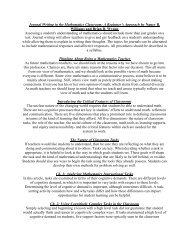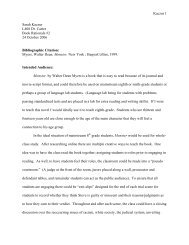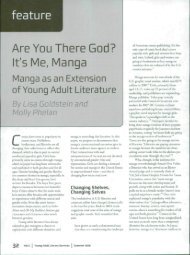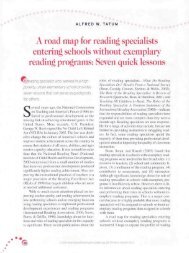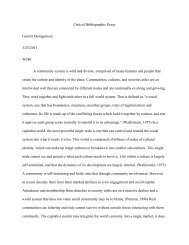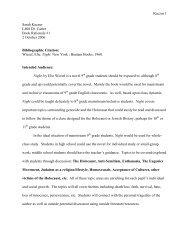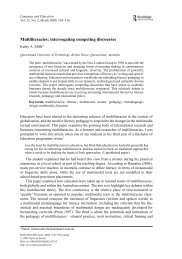Dyson 2003 Welcome to the Jam.pdf - Oncourse
Dyson 2003 Welcome to the Jam.pdf - Oncourse
Dyson 2003 Welcome to the Jam.pdf - Oncourse
You also want an ePaper? Increase the reach of your titles
YUMPU automatically turns print PDFs into web optimized ePapers that Google loves.
“<strong>Welcome</strong> <strong>to</strong> <strong>the</strong> <strong>Jam</strong>”<br />
anne haas dyson<br />
There is nothing unusual about Noah and Tommy’s play with appealing<br />
voices. Research on family conversation and language development (e.g.,<br />
Dore, 1989; Nelson, 1996), s<strong>to</strong>rytelling (Miller & Mehler, 1994), literary response<br />
(e.g., Miller, Hoogstra, Mintz, Fung, & Williams, 1993), and dramatic<br />
play (e.g., Garvey, 1990) all illustrate children’s attentiveness <strong>to</strong> plot lines and<br />
character voices that are aes<strong>the</strong>tically marked, affectively charged, and allow<br />
<strong>the</strong>m <strong>to</strong> assume appealing and/or powerful positions.<br />
Indeed, this attentiveness <strong>to</strong> voices supports children’s entry in<strong>to</strong> language<br />
itself. Children learn words as <strong>the</strong>y participate with o<strong>the</strong>rs in <strong>the</strong>ir everyday<br />
practices (e.g., dressing, eating, “peek-a-boo” games) (Bruner, 1990; Nelson,<br />
1996). To use <strong>the</strong> concepts of <strong>the</strong> language philosopher Bakhtin (1981), children<br />
re-voice those offered words, “re-accenting” <strong>the</strong>m with <strong>the</strong>ir own intentions.<br />
In this way, children form a sense of <strong>the</strong>ir own agency, <strong>the</strong>ir own possibilities<br />
for action, as <strong>the</strong>y slip in<strong>to</strong> <strong>the</strong> voices that organize <strong>the</strong>ir social worlds,<br />
including <strong>the</strong>ir routine practices.<br />
The typicality of those voices, <strong>the</strong>ir ways of enacting a typical social situation,<br />
indicates <strong>the</strong>ir generic quality. Indeed, genres can be viewed as kinds of<br />
practices (Hanks, 1996), that is, as ways of participating in <strong>the</strong> recurrent social<br />
activities of a society. These typified voices, or genres, result from <strong>the</strong> many<br />
people who have participated in similar situations, adopting certain evaluative<br />
stances <strong>to</strong>ward o<strong>the</strong>rs and <strong>the</strong> world, speaking and singing certain <strong>the</strong>matic<br />
content in structurally compatible ways (Bakhtin, 1986). Ways of telling s<strong>to</strong>ries<br />
(through varied media), of reporting local and national news, and of celebrating,<br />
communicating, or praying through song are all typical voices or generic<br />
texts, and yet all are made manifest through particular and unique encounters,<br />
or dialogues, between speakers and listeners, readers and writers<br />
(Bakhtin, 1981).<br />
Textual Toys in Childhood Spaces<br />
Although <strong>the</strong> particularities of childhoods vary across his<strong>to</strong>rical time and cultural<br />
space, children all over <strong>the</strong> globe are alert <strong>to</strong> <strong>the</strong> voice-filled landscape of<br />
<strong>the</strong>ir everyday lives. Within that landscape, <strong>the</strong>y may find textual <strong>to</strong>ys — symbolic<br />
material useful for conversation, collaborative play, and group singing —<br />
in <strong>the</strong> words of human and electronic voices. Among <strong>the</strong> latter are radio deejays<br />
and singing stars, TV sports commenta<strong>to</strong>rs and movie characters.<br />
Through an eclectic mix of appealing symbolic stuff (including both longstanding<br />
childhood rhymes and more ephemeral media materials), children<br />
engage in cultural and expressive practices and <strong>the</strong>reby produce friendships<br />
and imaginative worlds (see also <strong>Dyson</strong>, 1993, 1997; Fisherkeller, 2002;<br />
Garvey, 1990; Jenkins, 1988; Newkirk, 2002; Opie & Opie, 1959). Indeed, <strong>the</strong><br />
cultural geographer Massey (1998) argues that youth cultures across <strong>the</strong> globe<br />
(if not particularly childhood cultures) are marked by an openness in which<br />
commercial media, however global <strong>the</strong>ir reach, are always localized in how<br />
331




